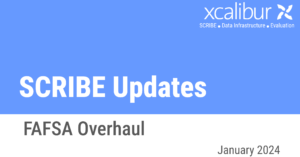In October, I reviewed the new FAFSA application. In my blog post found here, I outlined all the changes the Department of Education was making in an attempt to improve the FAFSA application form. These changes by the DOE were intentional to make it easier and shorter to complete. Since October, the Department of Education has struggled to provide accurate deadlines for the release of this new FAFSA application, pushing the deadline back from December 1st, 2023 to December 31st. Once released, the form was only intermittently available to the public, with communication to those attempting to access the application with information such as “form temporarily unavailable due to soft launch” and “routine maintenance”. With these obstacles to accessing the FAFSA application on schedule (typically FAFSA opens on October 1st of each year) many have wondered how this will impact students/families as they wait to know how much student financial aid will be available to them. Within the GEAR UP community, concerns are growing for the 1st generation population as intermittent availability and a decreased application window will restrict secondary institution’s support with students/families to find additional funds to supplement tuition/fees not covered by federal aid.
 Released just recently by NPR, the Department of Education has found the new algorithm which calculates the new field “Student Aid Index” (formerly known as Estimated Family Contribution) on the FAFSA application was calculated incorrectly, leaving many students with an artificially inflated “SAI” impacting their eligibility for federal and other financial aid. This error, while known by the DOE, does not appear to have a timeline for correction. With this additional set back, a much wider gap of frustration and unknowns for students/families is being felt nationwide as to whether or not postsecondary education is affordable. As a data nerd and one tapped into postsecondary immediate matriculation and persistence data, I can’t help but wonder if this will result in a decline of PSE enrollment. Not only does the FAFSA influence financial aid for first year post secondary students but for returning students as well. This inflation may cause students who qualified for needs based aid in previous applications to not qualify in the upcoming school year.
Released just recently by NPR, the Department of Education has found the new algorithm which calculates the new field “Student Aid Index” (formerly known as Estimated Family Contribution) on the FAFSA application was calculated incorrectly, leaving many students with an artificially inflated “SAI” impacting their eligibility for federal and other financial aid. This error, while known by the DOE, does not appear to have a timeline for correction. With this additional set back, a much wider gap of frustration and unknowns for students/families is being felt nationwide as to whether or not postsecondary education is affordable. As a data nerd and one tapped into postsecondary immediate matriculation and persistence data, I can’t help but wonder if this will result in a decline of PSE enrollment. Not only does the FAFSA influence financial aid for first year post secondary students but for returning students as well. This inflation may cause students who qualified for needs based aid in previous applications to not qualify in the upcoming school year.
While there certainly are many questions arising in terms of the new FAFSA application, Xcalibur has been working diligently the last several months to make changes to FAFSA reporting in our SCRIBE student database for GEAR UP. Retiring old fields such as Family Contribution and creating new data fields for better data collection and reporting such as “selected for verification” has been a priority for our development and evaluation team. The new FAFSA fields also allow for multiple years of FAFSA status to be added to a student’s SCRIBE profile. In addition, we have made changes to many of our reports that contained FAFSA data and are currently working to update federal reports tied to FAFSA data in the SCRIBE database. If you are a SCRIBE user, check out this article linked in our Help Desk to see what changes we have made to the data entry and reporting for FAFSA data!
